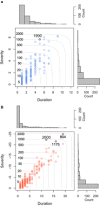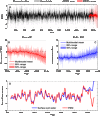Past and future drought in Mongolia
- PMID: 29546236
- PMCID: PMC5851680
- DOI: 10.1126/sciadv.1701832
Past and future drought in Mongolia
Abstract
The severity of recent droughts in semiarid regions is increasingly attributed to anthropogenic climate change, but it is unclear whether these moisture anomalies exceed those of the past and how past variability compares to future projections. On the Mongolian Plateau, a recent decade-long drought that exceeded the variability in the instrumental record was associated with economic, social, and environmental change. We evaluate this drought using an annual reconstruction of the Palmer Drought Severity Index (PDSI) spanning the last 2060 years in concert with simulations of past and future drought through the year 2100 CE. We show that although the most recent drought and pluvial were highly unusual in the last 2000 years, exceeding the 900-year return interval in both cases, these events were not unprecedented in the 2060-year reconstruction, and events of similar duration and severity occur in paleoclimate, historical, and future climate simulations. The Community Earth System Model (CESM) ensemble suggests a drying trend until at least the middle of the 21st century, when this trend reverses as a consequence of elevated precipitation. Although the potential direct effects of elevated CO2 on plant water use efficiency exacerbate uncertainties about future hydroclimate trends, these results suggest that future drought projections for Mongolia are unlikely to exceed those of the last two millennia, despite projected warming.
Figures




References
-
- Belmecheri S., Babst F., Wahl E. R., Stahle D. W., Trouet V., Multi-century evaluation of Sierra Nevada snowpack. Nat. Clim. Change 6, 2–3 (2016).
-
- Griffin D., Anchukaitis K. J., How unusual is the 2012–2014 California drought? Geophys. Res. Lett. 41, 9017–9023 (2014).
-
- Cook B. I., Smerdon J. E., Seager R., Coats S., Global warming and 21st century drying. Clim. Dyn. 43, 2607–2627 (2014).
-
- Karnauskas K. B., Donnelly J. P., Anchukaitis K. J., Future freshwater stress for island populations. Nat. Clim. Chang. 6, 720–725 (2016).
Publication types
LinkOut - more resources
Full Text Sources
Other Literature Sources
Miscellaneous

